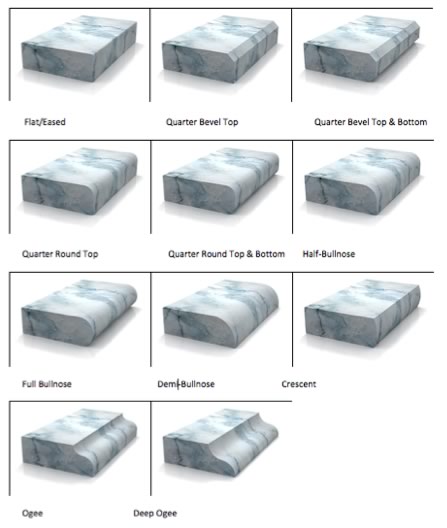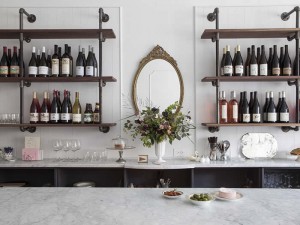Details and FAQ’s
Why do I need a Capital Improvement Form?
Signing a Capital Improvement Form allows us not to charge you sales tax.
What is a Capital Improvement Form?
A capital improvement is any addition or alteration to real property that meets all three of the following conditions:
- It substantially adds to the value of the real property, or appreciably prolongs the useful life of the real property.
- It becomes part of the real property or is permanently affixed to the real property so that removal would cause material damage to the property or article itself.
- It is intended to become a permanent installation.
For example, building a deck, installing a hot water heater, or installing kitchen cabinets are all capital improvement projects. Repairing a broken step, replacing a thermostat on a hot water heater, or painting existing cabinets are all examples of taxable repair and maintenance work.
How to get started towards purchasing your Marble, Granite and/or Limestone Countertops?
How to get started towards purchasing your Marble, Granite and/or Limestone Countertops.
- Fax or e-mail a copy of your sketch or project plans with dimensions to us.
- Pick your stone from Barra & Trumbore’s warehouse stock or at your favorite distributor with our assistance.
- Select the Edge profile type for your Countertops.
- Determine the height and thickness of your backsplash
- Actual measurements are taken when we come to template after cabinets are installed.
- When purchasing natural stone Countertops fabrication, these options will affect the look and price of your design.
Material type Material thickness Edge type Linear feet of edge work Length and height of back splashes Cutouts for under mount or drop-in sink Cutouts for cook top or oven/range
Remember, all Countertops fabrication is not the same. When shopping, don’t just compare price. Ask the fabricator for the following information:
How will the Countertops edges be finished? How high are the back splashes? Will there be any reinforcement rods? How many seams will there be? Where will the seams be? Where will the seams be in the back splashes?
Thickness
The stone industry has three standard thicknesses: 2cm, 3cm, and 5cm.
Edge Profiles

Stone Care Tips
Many people assume that stone is a permanent material that does not need maintenance or care. After new stone is installed, permanent damage can occur due to neglect, incorrect cleaning methods, and using chemicals that are not formulated for stone care. Here are some recommendations for routine care and cleaning.
Precautions
- Use coasters under all glasses, particularly those containing alcohol or citrus juices. Many common foods and drinks contain acids that will etch or dull the stone surface.
- Do not place hot items directly on the stone surface. Use trivets or mats under hot dishes and placemats under china, ceramics, silver or other objects that can scratch the surface.
Preventative Maintenance
- Many of the commercial conventional products that are labeled “Neutral”, “All-Purpose” cleaners can have a PH ranging from slightly acidic 6 to an alkaline base of 8-10. The chemical reactions of these cleaners are gradual; they will eventually dull the natural polish of the stone and discolor it over time. It is not recommended using these “all-purpose” cleaners on stone surfaces.
- Due to its absorbent nature, some varieties more so than others, will absorb liquids and oils, causing stains, discolorations or irreversible mineralogical chemical changes in the stone. These processes are greatly minimized by having the stone treated with a penetrating water or oil repellent.
Cleaning Procedures and Recommendations:
Clean stone surfaces with a few drops of neutral cleaner, stone soap (available at hardware stores or from your stone dealer) or a mild liquid soap dishwashing detergent and warm water. Use a clean rag mop on floors and a soft cloth for other surfaces for best results. Too much cleaner or soap may leave a film and cause streaks. Do not use products that contain lemon, vinegar or other acids on marble or limestone. Rinse the surface thoroughly after washing with soap solution and dry with a soft cloth. Change the rinse water frequently. Do not use scouring powders or creams; these products contain abrasives that may scratch the surface.
Vanity Top Surfaces
Vanity tops may need to have a penetrating sealer applied. Check with your installer for recommendations. A good quality marble wax or a non-yellowing automobile paste wax can be applied to minimize water spotting.
Food Preparation Areas
In food preparation areas, the stone may need to have a penetrating sealer applied. Check with your installer for recommendations. If a sealer is applied be sure that it is non-toxic and safe for use on food preparation surfaces. If there are questions, check with the sealer manufacturer.
Please note: Barra & Trumbore Inc. seals all stone, unless otherwise requested, before it leaves the shop. It is up to customer discretion whether or not to reseal their stone in the future.
Preservations
Sealing: Water repellants Silicone (synthetic oils): Generic synthetic oils which tend to leach from surfaces and migrate; of limited use due to the tendency of attracting dust and limited life expectancy. There are many types, but you can generally rely upon the fact that you get what you pay for.
Siliconates: An inexpensive, water based silicone derivative useful for light colored, porous stone. This type should not be used on dark colored stone or important surfaces. Any residues not absorbed will disfigure surface with a salt-like precipitate. This may be useful for some limestone and concrete surfaces.
Siloxane: These are state of the art today in long life and high vapor transmission; moderate cost. Used primarily for exterior stone surfaces including marble, granite, limestone, slate and cement based building products. This is highly recommended for most stone surfaces exposed to weather and/or high humidity.
Stearates: This is the cheap water repellent sold to consumers in chain stores and hardware stores for wood, concrete, masonry, etc. – performance is poor and short lived. This is not recommended for most building stone.
Oil Repellents: These are proprietary products which repel oil, water and other liquids. There are a number of these specialized products designed for use on stone surfaces.
Drying Oils: These are the original natural polymers. They include Tung, Linseed and Soy. These oils become solid as they dry and are of potential use for sealing stone surfaces. They are organic and hence they are relatively sensitive to aging and may yellow with age, but are useful in some situations.
Waxes: Waxes may be natural or synthetic and include Carnuaba, paraffin, montan, beeswax, etc. They are typically formulated into paste waxes or emulsions for sealing purposes. Their effect is not permanent and typically they are reapplied on a regular basis.
Silicates: These are mineral glasses which fill up pores to make porous surfaces dense. Very useful for restoration of stone which is under chemical attack or exterior weathering as it can replace lost minerals and provide protection from further degeneration. They are specialized materials which require expertise to formulate and to apply.
Finishing Dressing
Waxes: This category is primarily paste waxes composed of paraffin, beeswax, and some synthetics. They can be very effective for maintaining shine and for prevention of stains. Some professional products contain dyes or pigments which can be useful in bringing out or maintaining the color of red, black and green stones. Carnuaba based waxes may be suitable for some low abrasive surfaces and is used in specialty maintenance products.
Coatings: Coatings are usually acrylics, urethanes, epoxies, varnishes, or lacquers and have limited use on natural stone. However, there are some typical uses of these film forming polymers. The most common coating is the janitorial type floor finish that is applied to floors to maintain a physical barrier which isolates the stone surface from abrasion. These coatings are considered temporary or sacrificial and are used primarily because the coating is easier to restore when it gets damaged than the stone surface would be without the coating. In general, film-forming coating is avoided on natural stone if possible.
Do’s and Don’ts
- Do clean surfaces with mild detergent or stone soap
- Do thoroughly rinse and dry the surface after washing
- Do blot up spills immediately
- Don’t use vinegar, lemon juice or other cleaners containing acids on marble, limestone, travertine or onyx surfaces
- Don’t use cleaners that contain acid such as bathroom cleaners, grout cleaners or tub and tile cleaners
- Don’t use abrasive cleaners such as dry cleansers or soft cleansers
- Don’t mix bleach and ammonia; this combination creates a toxic and lethal gas
Call your professional stone supplier, installer or restoration specialist for problems that appear too difficult to treat.
Things we do before we template
- Please be sure that all required information and items are on site and ready prior to templating. The most frequent cause of installation delays is a lack of “readiness” at time of templating.
- Please ensure that the area being templated is free of any other people or tradesman while the template is taking place.
- The area should be in the same condition when we template as when we install.
- Existing countertop, sink and backsplash must be removed. Surface should be level and flat.
- Cabinets should be installed in their permanent location, attached to the wall and leveled.
- Sinks must be on the jobsite at the time of template.
- Lightweight under mount sinks and drop in sinks will be installed by Barra & Trumbore and may be transported back to our shop after the template visit.
- Heavy cast iron/porcelain sinks will require a wooden cradle underneath to support the weight of the sink. This should be in place by the homeowner prior to templating.
- Farmhouse sinks should be set into place in the cabinet, but not yet plumbed, prior to templating.
- Faucets and soap dispensers should be on site at the time of template. Customer must approve placement.
- Large appliances that abut the stone should be set into place prior to templating.
- Cook tops should be on site prior to templating.
- Changes made after the template is taken could adversely affect the installation and additional charges may be added to your final bill.

